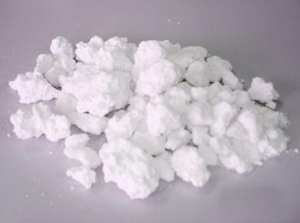







Search:

Calcium chloride
|
1. Ammonium carbonate |
|
$Ca^{2+}$ $+$ $CO_3^{2-}$ $\longrightarrow$ $CaCO_3$ - White precipitate - Soluble in $HCl$ - Soluble in acetic acid |
|
2. Potassium bichromate |
|
- no precipitation - $K_2CrO_4$ does not precipitate either $Ca^{2+}$ |
|
3. Diluted sulfuric cid |
|
no precipitation unless $SO_4^{2-}$ ions are abundant |
|
4. Ammonium oxalate $(NH_4)_2C_2O_4$ |
|
$Ca^{2+}$ $+$ $C_2O_4^{2-}$ $\longrightarrow$ $CaC_2O_4$ - White precipitate - Soluble in $HCl$ - Soluble in $HNO_3$ - Insoluble in acetic acid |
|
5. Potassium hexacyanoferrate(II) de ($K_4Fe(CN)_6$) |
|
$Ca^{2+}$ $+$ $[Fe(CN)_6]^{4-}$ $\longrightarrow$ $Ca_2[Fe(CN)_6]$ - Light yellow precipitate - Slow reaction accelerated by heat - Can detect $Ca^{2+} $ in the presence of $Sr^{2+}$ |
|
6. Glyoxal bis 2 hydroxyanil |
|
Introduce successively in a microtube - Test solution .... 5 drops - Reagent solution in ethanol .... 15 drops $ - $ 10% NaOH solution .... 3 drops - 10% solution of $Na_2CO_3$ 3 .... drops - 15 drops chloroform .... Shake, chloroform takes raspberry-red color Hinders: uranium |
|
7. Murexide |
|
Introduce a trace of murexide in the cavity of a porcelain plate, add - 10% $NaOH$ ... 1 drops - Distilled water .... 3-5 drops - Test solution .... 2 drops By shaking the solution changes from purple to orange. The reaction is not specific, but $Ba^{2+}$ and $Mg^{2+}$ do not react, the effect of $Sr^{2+}$ is uncertain |